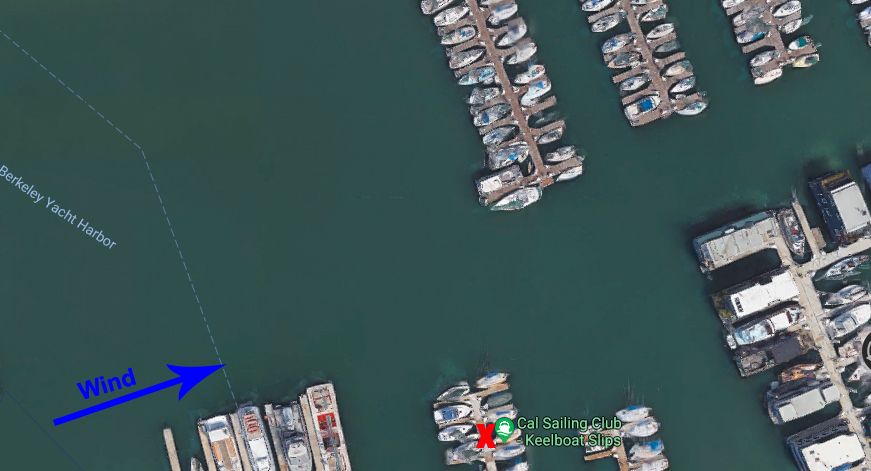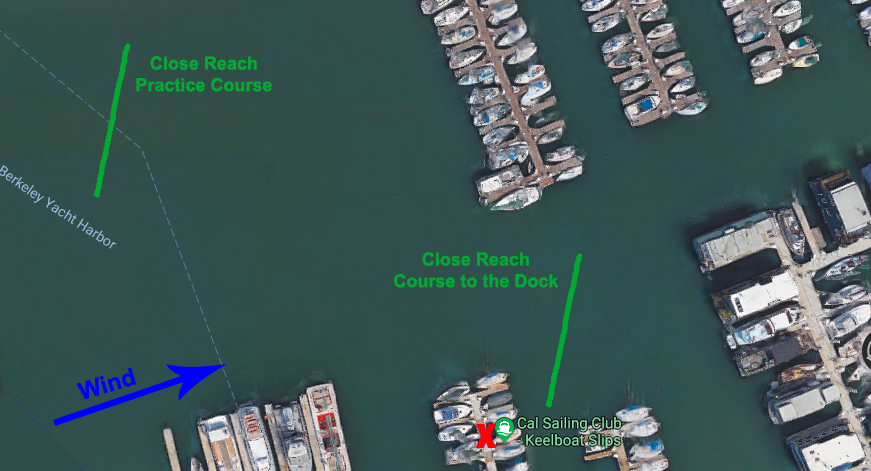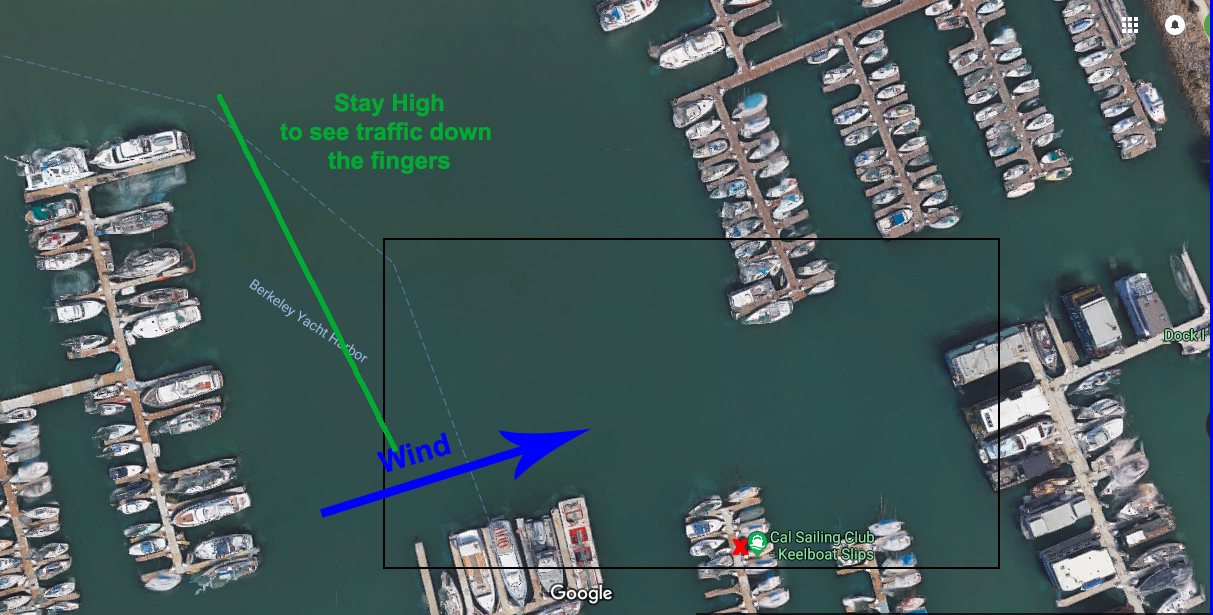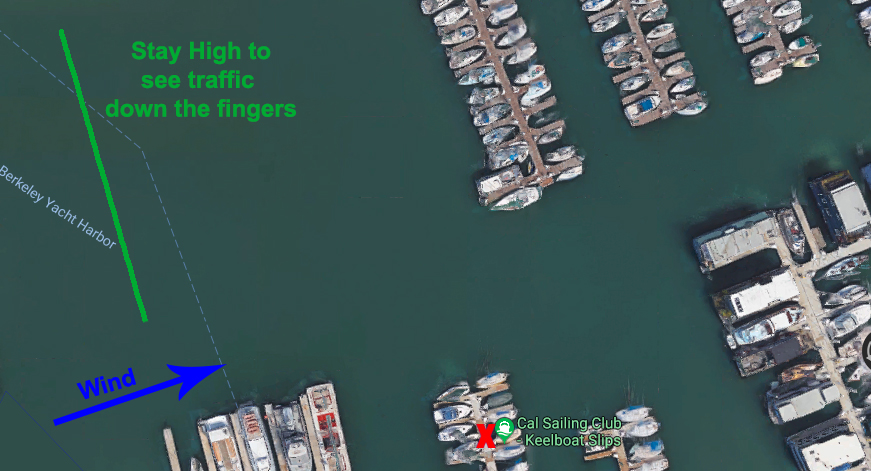Keelboat Docking - Part 2 - Space is Time
Docking our keelboats under sail is one of the most difficult skills required for the Senior Rating. This series of blogs is intended to give you a conceptual framework for doing it. With that framework and a lot of practice, you'll acquire this important skill.
For simplicity, we're talking about a "normal" upwind docking into a CSC slip, where the true wind is out of the West or South-West, but not too far South.
Here is a map of the south-east part of the Berkeley Marina, where J-Dock is, assuming a normal West or South-West wind:

And here's the blow-up of the turning basin and our docks:

Important Note: I will be showing some sample course lines in the blog to illustrate the main points. These particular course lines are for a very specific wind condition, which is indicated in the diagrams. It is a big mistake to think of your docking course lines in terms of geography (e.g., turn up as you pass the stern of the Red Boat). These course lines will change with the wind, and you should always be thinking in terms of the wind.
The Approach
Just like in a dinghy, you're approaching on a Close Reach to a half boat length before the dock and then turning into the wind to stop at the dock. Except with a slip, you can't actually sail that course, you have to aim farther down, like the end of the slip or maybe a half boat-length out. In both the dinghy and the keelboat case, you turn into the wind at the end and slow down to gently touch the dock.
In some respects, it's easier for the keelboats, because you don't have to get all the way into the slip, you just have to get far enough into the slip for your crew to step off and stop the boat. In other respects, it's harder, as the boat powers up and slows down much more slowly (especially a Commander). If you lose speed a half a boat-length away from the dock, you're in trouble.
A Close Reach is 60° to the True Wind, very easy to see at the dinghy dock from the windsocks, but there are even more indicators in the Marina - flags and masthead vanes.
For both dinghies and keelboats, you can do a Close Reach Practice Course away from the dock, and for keelboats you do this in the turning basin. You'll see the true wind when the jib and the boom are over the center of the boat. But don't get fooled by thinking that your Slow Sailing/Close Reach course is when you get a big luff in the sails in the turning basin. Because of apparent wind dynamics, this course is lower than you need to be. See on my first blog on this. When you do your Practice Course, you're visualizing a slow sailing course that you will then apply when you actually dock. Then you translate that course to tell you where you will turn to be on it to the dock.
So you want to setup a Slow Sailing course to your point of reference for turning upwind, either the end of the slip or a half boat length out from it. This is what the translation looks like:

And in the blow-up:

How to Approach to See Potential Traffic
When you come in, you don't want to be surprised by traffic. Sure, you have right-of-way over most of them, but do you want to press that in close quarters? And there are others who sail into and out of their slips (bravi!), and also human powered boats (tell me the right of way rules on that one -hint: it doesn't exist). So you want an approach where you can can see as much of this as possible, and you want to be able to scan 360° . This means going pretty high, so you get a good view of all of the fingers:

And on the blow-up:

This is the one time you are orienting yourself geographically, but even here you have to pay attention to the wind. If the wind goes significantly North or South, it will become more complicated.
As you come into the turning basin, you should be checking for traffic constantly, a full 360°
scan. Boats can appear quickly out of any of the fairways, including the ferries which depart K Dock at speed.
Space is Time
Sheldon's corrolary to Einstein, and it's incredibly important as it applies to your final approach to the dock on your slow-sailing line. The longer this course is (the farther away from your turn into the dock), or the more space you have, the more time you have to correct for speed (too fast, too slow) and for wind shifts. This means you want to make your turn onto your slow-sailing course as far away from the dock as possible. If you make a slow, long-radius turn into the dock, you are giving up space and margin for correction. So make a sharp turn, which will also bleed off a lot of speed.
In our "standard" conditions of West or South-West wind, this means going as close as safely possible to the boats on the opposite site (the Red Boat and others) before making your turn. But you need to keep enough distance from these expensive boats not to risk damage when you turn and your stern swings out, especially if your motor is up and projecting out from the stern. Pay close attention to your boom and your motor as you turn, a boat length away is a reasonable distance.
So your course will look like this:

And on the blow-up:

I'll repear that you want to make a very tight turn when you go to your slow-sailing course. There are two reasons for this. One is that with a tight turn, you don't give up much space (hence time) on your final approach to the dock. The other is that a tight turn will bleed off a lot of speed, so you can control your speed better in higher winds. In lighter winds, you might want to go with a wider turn, though, to keep your speed up.
Next Blog
Next time, I'll discuss one of the most important parts of docking, having a Plan B and a decision point.
When you subscribe to the blog, we will send you an e-mail when there are new updates on the site so you wouldn't miss them.


Comments 1
Love this. Great work, very informative. Thanks!